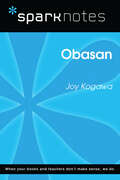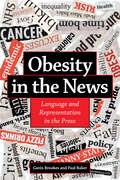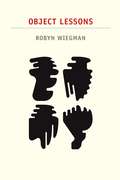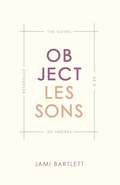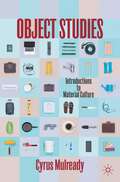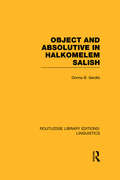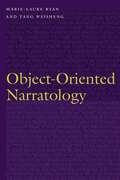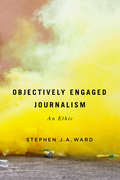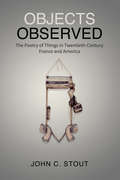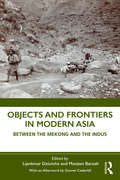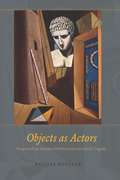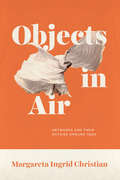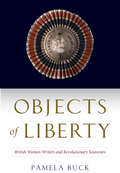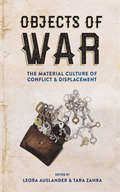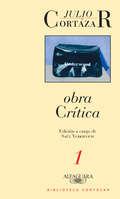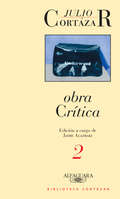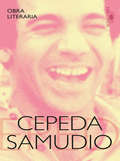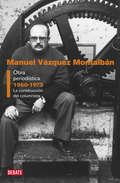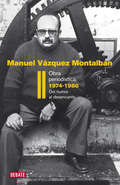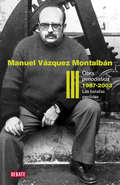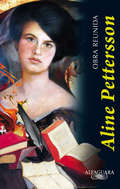- Table View
- List View
Obasan (SparkNotes Literature Guide Series)
by SparkNotesObasan (SparkNotes Literature Guide) by Joy Kogawa Making the reading experience fun! Created by Harvard students for students everywhere, SparkNotes is a new breed of study guide: smarter, better, faster. Geared to what today's students need to know, SparkNotes provides: *Chapter-by-chapter analysis *Explanations of key themes, motifs, and symbols *A review quiz and essay topicsLively and accessible, these guides are perfect for late-night studying and writing papers
Obesity in the News: Language and Representation in the Press
by Paul Baker Gavin BrookesObesity is a pressing social issue and a persistently newsworthy topic for the media. This book examines the linguistic representation of obesity in the British press. It combines techniques from corpus linguistics with critical discourse studies to analyse a large corpus of newspaper articles (36 million words) representing ten years of obesity coverage. These articles are studied from a range of methodological perspectives, and analytical themes include variation between newspapers, change over time, diet and exercise, gender and social class. The volume also investigates the language that readers use when responding to obesity representations in the context of online comments. The authors reveal the power of linguistic choices to shame and stigmatise people with obesity, presenting them as irresponsible and morally deviant. Yet the analysis also demonstrates the potential for alternative representations which place greater focus on the role that social and political forces play in this topical health issue.
Object Lessons
by Robyn WiegmanNo concept has been more central to the emergence and evolution of identity studies than social justice. In historical and theoretical accounts, it crystallizes the progressive politics that have shaped the academic study of race, gender, and sexuality. Yet few scholars have deliberated directly on the political agency that notions of justice confer on critical practice. In Object Lessons, Robyn Wiegman contemplates this lack of attention, offering the first sustained inquiry into the political desire that galvanizes identity fields. In each chapter, she examines a key debate by considering the political aspirations that shape it. Addressing Women's Studies, she traces the ways that "gender" promises to overcome the exclusions of "women." Turning to Ethnic Studies, she examines the deconstruction of "whiteness" as an antiracist methodology. As she explores American Studies, she links internationalization to the broader quest for noncomplicity in contemporary criticism. Her analysis of Queer Studies demonstrates how the commitment to antinormativity normalizes the field. In the penultimate chapter, Wiegman addresses intersectionality as the most coveted theoretical approach to political resolution in all of these fields.
Object Lessons: The Novel as a Theory of Reference
by Jami BartlettObject Lessons explores a fundamental question about literary realism: How can language evoke that which is not language and render objects as real entities? Drawing on theories of reference in the philosophy of language, Jami Bartlett examines novels by George Meredith, William Makepeace Thackeray, Elizabeth Gaskell, and Iris Murdoch that provide allegories of language use in their descriptions, characters, and plots. Bartlett shows how these authors depict the philosophical complexities of reference by writing through and about referring terms, the names and descriptions that allow us to “see” objects. At the same time, she explores what it is for words to have meaning and delves into the conditions under which a reference can be understood. Ultimately, Object Lessons reveals not only how novels make references, but also how they are about referring.
Object Studies: Introductions to Material Culture
by Cyrus MulreadyObject Studies: Introductions to Material Culture is a textbook that introduces students to an interdisciplinary approach to material cultural study. This text helps reveal how everyday objects from pens and coffee cups to our most cherished keepsakes help define our collective histories and personal narratives. Object Studies is organized around accessible and engaging chapters on objects with “model essays” that present original projects designed to engage students with a series of concepts and research activities. Each will demonstrate a key methodology tied to specific learning outcomes, but all chapters will be intertwined in their attention to the project of developing the core skills of “object studies”: careful viewing, writing detailed descriptions, setting out and testing research hypotheses, and telling stories through material artifacts. Aimed towards undergraduate students taking courses in material culture as well as postgraduate students embarking on independent research projects these chapter “studies” are practically oriented and demonstrate research projects that can be undertaken either in a course or even through personal study. Chapters in Object Studies conclude with research questions, suggestions on methodology, and a discursive bibliography designed to help students pursue their own projects based on these examples.
Object and Absolutive in Halkomelem Salish: Linguistics: Object And Absolutive In Halkomelem Salish (rle Linguistics F: World Linguistics) (Routledge Library Editions: Linguistics)
by Donna B. GerdtsThis book treats aspects of the syntax of Halkomelem, a Salish language spoken in southwestern British Columbia, specifically those constructions which involve objects, and seeks to accomplish two goals. First, it provides natural language fodder for the debate concerning the nature of grammatical relations and their place in syntactic theory. Second, by showing that Halkomelem draws from a familiar class of universal constructions and organizes its syntax around some simple and common parameters, the author has brought the Salish languages, which due to their phonological and morphological complexity seemed particularly fearsome, into cross-linguistic perspective.
Object-Oriented Narratology (Frontiers of Narrative)
by Marie-Laure Ryan Tang WeishengThe quick spread of posthumanism and of critiques of anthropomorphism in the past few decades has resulted in greater attention to concrete objects in critical theories and in philosophy. This new materialism or new object philosophy marks a renewal of interest in the existence of objects. Yet while their mode of existence is independent of human cognition, it cannot erase the relation of subject to object and the foundational role of our experience of things in our mental activity. These developments have important implications for narratology. Traditional conceptions of narrative define its core components as setting, characters, and plot, but nonhuman entities play a crucial role in characterizing the setting, in enabling or impeding the actions of characters, and thus in determining plot. Marie-Laure Ryan and Tang Weisheng combine a theoretical approach that defines the basic narrative functions of objects with interpretive studies of narrative texts that rely more closely on ideas advanced by proponents of new object philosophy. Object-Oriented Narratology opens new theoretical horizons for narratology and offers individual case studies that demonstrate the richness and diversity of the ways in which narrative, both Western and non-Western, deals with humans&’ relationships to their material environment and with the otherness of objects.
Objectively Engaged Journalism: An Ethic (McGill-Queen's Studies in the History of Ideas #78)
by Stephen J.A. WardA timely call for a new ethic of journalism engagement for today's troubled media sphere, Objectively Engaged Journalism argues that media should be neither neutral nor partisan but engaged in protecting egalitarian democracy. It shows how journalists, professional or citizen, can be both objective in method and dedicated to improving a global public sphere toxic with disinformation, fake news, and extremism. Drawing from history, ethics, and current media issues, Stephen Ward rejects the ideals of neutrality and "just the facts" objectivity, showing how they are based on invalid dualistic thinking with deep roots in Western culture. He presents a theory of pragmatic objectivity and applies it to journalism. Journalism's role in interpreting culture, he argues, needs a form of objectivity that embraces human strengths and limitations. Defining responsible journalism as situated, imperfect inquiry, Objectively Engaged Journalism is one of the first systematic studies of the ethical foundations of engaged journalism for a media that is increasingly perspectival and embedded in society.
Objectively Engaged Journalism: An Ethic (McGill-Queen's Studies in the History of Ideas)
by Stephen J.A. WardA timely call for a new ethic of journalism engagement for today's troubled media sphere, Objectively Engaged Journalism argues that media should be neither neutral nor partisan but engaged in protecting egalitarian democracy. It shows how journalists, professional or citizen, can be both objective in method and dedicated to improving a global public sphere toxic with disinformation, fake news, and extremism. Drawing from history, ethics, and current media issues, Stephen Ward rejects the ideals of neutrality and "just the facts" objectivity, showing how they are based on invalid dualistic thinking with deep roots in Western culture. He presents a theory of pragmatic objectivity and applies it to journalism. Journalism's role in interpreting culture, he argues, needs a form of objectivity that embraces human strengths and limitations. Defining responsible journalism as situated, imperfect inquiry, Objectively Engaged Journalism is one of the first systematic studies of the ethical foundations of engaged journalism for a media that is increasingly perspectival and embedded in society.
Objects Observed: The Poetry of Things in Twentieth-Century France and America (University of Toronto Romance Series)
by John Cameron StoutObjects Observed explores the central place given to the object by a number of poets in France and in America in the twentieth century. John C. Stout provides comprehensive examinations of Pierre Reverdy, Francis Ponge, Jean Follain, Guillevic, and Jean Tortel. Stout argues that the object furnishes these poets with a catalyst for creating a new poetics and for reflecting on lyric as a genre. In France, the object has been central to a broad range of aesthetic practices, from the era of Cubism and Surrealism to the 1990s. In the heyday of American Modernism, several major poets foregrounded the object in their work; however, in postwar twentieth-century America, poets moved away from a focus on the object. Objects Observed illuminates the variety of aesthetic practices and positions in French and American poets from the years of high Modernism (1909–1930) to the 1990s.
Objects and Frontiers in Modern Asia: Between the Mekong and the Indus
by Lipokmar Dzüvichü Manjeet BaruahFocusing on the geographies between the Mekong and the Indus, this book brings objects to the centre of enquiry in the understanding of modern Asian frontiers. It explores how a range of objects have historically been significant bearers and agents of frontier making. For instance, how are objects connected to aspects of state making, social change, everyday life, diplomacy, political and ecological worlds, capital, forms of violence, resistances, circulations, and aesthetic expressions? This book seeks to interrogate and understand the dynamism of frontiers from the vantage point of objects such as salt, rubber, tea, guns, silk scarves, horses, and opium. It attempts to explore objects as sites of encounter, mediation, or dislocation between the social and the spatial. The book not only locates objects in the specificities of frontier spaces, but it also looks at how they are produced, circulated, and come to be intricately linked to a wide range of people, institutions, networks, and geographies. In the process, it explores how objects traverse and come to inhabit multiple historical, cultural, and geographical scales. This book will be of interest to researchers and academics working in areas of history, social and cultural anthropology, Asian studies, frontiers and borderland studies, cultural studies, political and economic studies, and museum studies.
Objects and Intertexts in Toni Morrison’s "Beloved": The Case for Reparations (Routledge Research in American Literature and Culture)
by Maureen E. FademObjects and Intertexts in Toni Morrison’s “Beloved”: The Case for Reparations is an inspired contribution to the scholarship on one of the most influential American novels and novelists. The author positions this contemporary classic as a meditation on historical justice and re-comprehends it as both a formal tragedy— a generic translation of fiction and tragedy or a “novel-tragedy” (Kliger)—and a novel of objects. Its many things—literary, conceptual,linguistic— are viewed as vessels carrying the (hi)story and the political concerns. From this, a third conclusion is drawn: Fadem argues for a view of Beloved as a case for reparations. That status is founded on two outstanding object lessons: the character of Beloved as embodiment of the subject-object relations defining the slave state and the grammatical object “weather” in the sentence “The rest is…” on the novel’s final page. This intertextual reference places Beloved in a comparative link with Hamlet and Oresteia. Fadem’s research is meticulous in engaging the full spectrum of tragedy theory, much critical theory, and a full swathe of scholarship on the novel. Few critics take up the matter of reparations, still fewer the politics of genre, craft, and form. This scholar posits Morrison’s tragedy as constituting a searing critique of modernity, as composed through meaningful intertextualities and as crafted by profound “thingly” objects (Brown). Altogether, Fadem has divined a fascinating singular treatment of Beloved exploring the connections between form and craft together with critical historical and political implications. The book argues, finally, that this novel’s first concern is justice, and its chief aim to serve as a clarion call for material— and not merely symbolic—reparations.
Objects as Actors: Props and the Poetics of Performance in Greek Tragedy
by Melissa MuellerObjects as Actors charts a new approach to Greek tragedy based on an obvious, yet often overlooked, fact: Greek tragedy was meant to be performed. As plays, the works were incomplete without physical items—theatrical props. In this book, Melissa Mueller ingeniously demonstrates the importance of objects in the staging and reception of Athenian tragedy. As Mueller shows, props such as weapons, textiles, and even letters were often fully integrated into a play’s action. They could provoke surprising plot turns, elicit bold viewer reactions, and provide some of tragedy’s most thrilling moments. Whether the sword of Sophocles’s Ajax, the tapestry in Aeschylus’s Agamemnon, or the tablet of Euripides’s Hippolytus, props demanded attention as a means of uniting—or disrupting—time, space, and genre. Insightful and original, Objects as Actors offers a fresh perspective on the central tragic texts—and encourages us to rethink ancient theater as a whole.
Objects in Air: Artworks and Their Outside around 1900
by Margareta Ingrid ChristianMargareta Ingrid Christian unpacks the ways in which, around 1900, art scholars, critics, and choreographers wrote about the artwork as an actual object in real time and space, surrounded and fluently connected to the viewer through the very air we breathe. Theorists such as Aby Warburg, Alois Riegl, Rainer Maria Rilke, and the choreographer Rudolf Laban drew on the science of their time to examine air as the material space surrounding an artwork, establishing its “milieu,” “atmosphere,” or “environment.” Christian explores how the artwork’s external space was seen to work as an aesthetic category in its own right, beginning with Rainer Maria Rilke’s observation that Rodin’s sculpture “exhales an atmosphere” and that Cezanne’s colors create “a calm, silken air” that pervades the empty rooms where the paintings are exhibited. Writers created an early theory of unbounded form that described what Christian calls an artwork’s ecstasis or its ability to stray outside its limits and engender its own space. Objects viewed in this perspective complicate the now-fashionable discourse of empathy aesthetics, the attention to self-projecting subjects, and the idea of the modernist self-contained artwork. For example, Christian invites us to historicize the immersive spatial installations and “environments” that have arisen since the 1960s and to consider their origins in turn-of-the-twentieth-century aesthetics. Throughout this beautifully written work, Christian offers ways for us to rethink entrenched narratives of aesthetics and modernism and to revisit alternatives.
Objects of Culture in the Literature of Imperial Spain
by Mary Barnard Frederick A. de ArmasCollecting and displaying finely crafted objects was a mark of character among the royals and aristocrats in Early Modern Spain: it ranked with extravagant hospitality as a sign of nobility and with virtue as a token of princely power. Objects of Culture in the Literature of Imperial Spain explores how the writers of the period shared the same impulse to collect, arrange, and display objects, though in imagined settings, as literary artefacts.These essays examine a variety of cultural objects described or alluded to in books from the Golden Age of Spanish literature, including clothing, paintings, tapestries, playing cards, monuments, materials of war, and even enchanted bronze heads. The contributors emphasize how literature preserved and transformed objects to endow them with new meaning for aesthetic, social, religious, and political purposes - whether to perpetuate certain habits of thought and belief, or to challenge accepted social and moral norms.
Objects of Liberty: British Women Writers and Revolutionary Souvenirs (EARLY MODERN FEMINISMS)
by Pamela BuckObjects of Liberty explores the prevalence of souvenirs in British women’s writing during the French Revolution and Napoleonic era. It argues that women writers employed the material and memorial object of the souvenir to circulate revolutionary ideas and engage in the masculine realm of political debate. While souvenir collecting was a standard practice of privileged men on the eighteenth-century Grand Tour, women began to partake in this endeavor as political events in France heightened interest in travel to the Continent. Looking at travel accounts by Helen Maria Williams, Mary Wollstonecraft, Catherine and Martha Wilmot, Charlotte Eaton, and Mary Shelley, this study reveals how they used souvenirs to affect political thought in Britain and contribute to conversations about individual and national identity. At a time when gendered beliefs precluded women from full citizenship, they used souvenirs to redefine themselves as legitimate political actors. Objects of Liberty is a story about the ways that women established political power and agency through material culture.
Objects of War: The Material Culture of Conflict and Displacement
by Tara Zahra Leora AuslanderHistorians have become increasingly interested in material culture as both a category of analysis and as a teaching tool. And yet the profession tends to be suspicious of things; words are its stock-in-trade. What new insights can historians gain about the past by thinking about things? A central object (and consequence) of modern warfare is the radical destruction and transformation of the material world. And yet we know little about the role of material culture in the history of war and forced displacement: objects carried in flight; objects stolen on battlefields; objects expropriated, reappropriated, and remembered.Objects of War illuminates the ways in which people have used things to grapple with the social, cultural, and psychological upheavals wrought by war and forced displacement. Chapters consider theft and pillaging as strategies of conquest; soldiers' relationships with their weapons; and the use of clothing and domestic goods by prisoners of war, extermination camp inmates, freed people, and refugees to make claims and to create a kind of normalcy.While studies of migration and material culture have proliferated in recent years, as have histories of the Napoleonic, colonial, World Wars, and postcolonial wars, few have focused on the movement of people and things in times of war across two centuries. This focus, in combination with a broad temporal canvas, serves historians and others well as they seek to push beyond the written word.Contributors:Noah Benninga, Sandra H. Dudley, Bonnie Effros, Cathleen M. Giustino, Alice Goff, Gerdien Jonker, Aubrey Pomerance, Iris Rachamimov, Brandon M. Schechter, Jeffrey Wallen, and Sarah Jones Weicksel
Obra crítica 1: Edición a cargo de Saúl Yurkievich
by Julio CortázarEn este primer volumen de la Obra crítica de Cortázar se publica su texto inédito Teoría del túnel, un libro sobre teoría literaria que fundaría las bases de su posterior trabajo novelístico. En paralelo a su obra literaria, Julio Cortázar produjo un considerable conjunto de textos críticos de altísimo valor, tanto por su agudeza interpretativa como por la atractiva brillantez de su prosa. La presente recopilación de esos trabajos, publicada originalmente en 1994, se organiza en tres volúmenes, a cargo de los especialistas Saúl Yurkievich (Teoría del túnel, 1947), Jaime Alazraki (textos anteriores a Rayuela) y Saúl Sosnowski (textos posteriores a Rayuela). Teoría del túnel, el texto que compone el primer volumen de la Obra crítica, Cortázar pasa revista a las orientaciones de la novela moderna y fundamenta sus propias opciones, situándose en relación con las tendencias más avanzadas de su época y enunciando su programa personal, que luego hallará expresión en Rayuela. Con este escrito, de lectura imprescindible, queda más completa la figura de Cortázar y más a la vista el maravilloso poliedro de su obra íntegra.
Obra crítica 2: Edición a cargo de Jaime Alazraki
by Julio CortázarEste segundo volumen de la Obra crítica de Cortázar recupera, de entre numerosas y diversas publicaciones, la producción ensayística del autor anterior a su obra cumbre, Rayuela. En paralelo a su obra literaria, Julio Cortázar produjo un considerable conjunto de textos críticos de altísimo valor, tanto por su agudeza interpretativa como por la atractiva brillantez de su prosa. La presente recopilación de esos trabajos, publicada originalmente en 1994, se organiza en tres volúmenes, a cargo de los especialistas Saúl Yurkievich ("Teoría del túnel", 1947), Jaime Alazraki (textos anteriores a Rayuela) y Saúl Sosnowski (textos posteriores a Rayuela). Los textos críticos de Cortázar estaban dispersos en muy diversas y distantes publicaciones. En este segundo volumen de la Obra crítica, Jaime Alazraki reunió aquellos producidos antes de Rayuela, a partir de la primera nota publicada en la revista Cabalgata. Con un perfecto dominio de la bibliografía cortazariana, Alazraki logró recuperar textos casi desconocidos, donde se anuncia la personalidad literaria de Julio Cortázar y se prefigura su trayectoria. Estos escritos, de lectura imprescindible, permiten completar la figura de Cortázar, dejando más a la vista el maravilloso poliedro de su obra íntegra.
Obra crítica 3: Edición a cargo de Saúl Sosnowski
by Julio CortázarEn este tercer volumen de la Obra crítica de Cortázar se presenta ya a un autor experimentado y dotado de firmes convicciones estéticas y políticas, a través de su producción ensayística posterior a Rayuela. Julio Cortázar, mientras iba escribiendo su obra literaria, produjo un considerable conjunto de textos críticos de altísimo valor, tanto por su agudeza interpretativa como por la atractiva brillantez de su prosa. Estos escritos constituyen una lectura imprescindible porque ponen de manifiesto las nociones y valores determinantes en la génesis de la literatura cortazariana. Con ellos queda más completa la figura de Cortázar, más a la vista el maravilloso poliedro de su obra íntegra. La presente recopilación de los textos críticos de Julio Cortázar se organiza en tres volúmenes, a cargo de tres especialistas que unen a su condición de eruditos y expertos la muy envidiable de amigos personales del autor: Saúl Yurkievich (Teoría del túnel, 1947), Jaime Alazraki (trabajos críticos anteriores a Rayuela, 1963) y Saúl Sosnowski (trabajos críticos posteriores a Rayuela). Los textos de Cortázar están dispersos en muy diversas y distantes publicaciones. Saúl Sosnowski recopila en este tercer volumen de la Obra crítica los textos posteriores a Rayuela, punto de inflexión no solo de la creatividad cortazariana, sino también de sus ideas sobre la literatura. Aquí se nos presenta con toda la viveza el conjunto de convicciones y conceptos estéticos, desde luego, pero también políticos de un hombre a quien apasionaban las reglas de la creatividad, pero que pensaba sobre todo en los destinos terrestres del ser humano.
Obra literaria
by Álvaro Cepeda SamudioLa obra completa de uno de los mejores autores y cuentistas del país. Este volumen contiene la obra completa de Álvaro Cepeda Samudiocompuesta por los libros de cuentos Todos estábamos a la espera y Loscuentos de Juana y por la novela La casa grande. La obra completa de uno de los mejores autores y cuentistas del país. Este volumen contiene la obra completa de Álvaro Cepeda Samudiocompuesta por los libros de cuentos Todos estábamos a la espera y Loscuentos de Juana y por la novela La casa grande.
Obra periodística 1960-1973: La construcción del columnista
by Manuel Vázquez MontalbánEste primer volumen de los tres que forman la obra periodística de Vázquez Montalbán reúne los artículos escritos desde sus comienzos en el periodismo hasta casi el final de la dictadura franquista. Manuel Vázquez Montalbán (Barcelona, 1939 - Bangkok, 2003) fue uno de los mayores renovadores de las letras españolas contemporáneas, referente inexcusable de la literatura española posterior a la Guerra Civil. Uno de los campos donde su influencia más se hizo notar fue en el del periodismo, desde el que escribió sobre los temas más diversos, siempre con una certera y lúcida visión de la realidad, no exenta de ironía y sentido del humor. Esta antología en tres volúmenes rescata lo mejor de su periodismo, una vocación que no abandonaría hasta el final de su vida y en la que destacó como pocos, convirtiéndose en lectura obligatoria de los jóvenes periodistas, incluso de nuestros días. Licenciado en Filosofía y Letras y en Periodismo, Vázquez Montalbán comenzó a colaborar en la prensa muy pronto, ya en 1960. Este primer volumen rescata sus trabajos periodísticos desde sus comienzos en 1960 en la prensa falangista (El Español y Solidaridad Nacional), hasta la etapa quizá más conocida, ya en los albores de la democracia, en Triunfo, donde coincidió con Eduardo Haro Tecglen y Fernando Savater, pasando por sus artículos en publicaciones como Siglo XX y Hogares Modernos, donde escribió tras su paso por prisión. Con esta antología preparada por Francesc Salgado, se recupera toda una época reciente de España, contada al más puro estilo de su autor: a través del fútbol, la gastronomía o la literatura, pero también mediante perfiles y entrevistas con los personajes del momento, artículos de opinión o análisis de política internacional. Reseñas:«La más brillante crónica de los años finales del franquismo.»José Luis García Marín, La Nueva España «Un libro impagable... Asombra leer hoy los artículos que Manolo publicó hace medio siglo porque están más vivos y tienen más frescura que tantos que padecemos hoy.»Luis Lagorri, Tiempo «Mil gracias a Debate y a Francesc Salgado por este primer volumen de la obra periodística de Manolo.»Joan de Sagarra, La Vanguardia
Obra periodística 1974-1986 (Obra periodística II): Del humor al desencanto
by Manuel Vázquez MontalbánEl segundo volumen de la obra periodística de Vázquez Montalbán recoge sus artículos más importantes escritos durante la transición y los primeros años de democracia. Manuel Vázquez Montalbán (Barcelona, 1939 - Bangkok, 2003) fue uno de los mayores renovadores de las letras españolas contemporáneas, referente inexcusable de la literatura española posterior a la Guerra Civil. Uno de los campos donde su influencia más se hizo notar fue en el del periodismo, desde el que escribió sobre los temas más diversos, siempre con una certera y lúcida visión de la realidad, no exenta de ironía y sentido del humor. Esta antología en tres volúmenes rescata lo mejor de su periodismo, una vocación que no abandonaría hasta el final de su vida y en la que destacó como pocos, convirtiéndose en lectura obligatoria de los jóvenes periodistas, incluso de nuestros días. Este segundo volumen arranca con un giro importante en la trayectoria de Vázquez Montalbán, ya que recoge la época en la que fundó Por Favor (1974-1978), Arreu (1976-1977) y La Calle (1978-1982), publicaciones que no sobrevivieron a los vaivenes de la Transición. Son también los años en que se incorporó a algunas de las publicaciones más importantes de la democracia como Interviú (1976), El Periódico de Catalunya (1978) o El País (1984) y en que arranca su exitosa carrera como novelista, con la obtención del Premio Planeta con Los mares del sur. A partir de entonces el columnista deberá convivir con el escritor de ficción. Con esta antología preparada por Francesc Salgado, se recupera toda una época reciente de España, contada al más puro estilo de su autor: a través del fútbol, la gastronomía o la literatura, pero también mediante perfiles y entrevistas con los personajes del momento, artículos de opinión o análisis de política internacional. Reseñas:«Una selección antológica que supera su carácter de testigo de una época y merece ser leída por periodistas y lectores que no la han conocido.»Lluís Bassets, El País «Sus artículos son a menudo extraordinarios ejercicios de estilo, así mantienen toda su vigencia y continúan siendo puntos de referencia.»Vicenç Villatoro, Avui
Obra periodística 1987-2003 (Obra periodística III): Las batallas perdidas
by Manuel Vázquez MontalbánEl tercer volumen de la antología de Vázquez Montalbán recoge su producción periodística desde 1987 hasta el final de sus días. Manuel Vázquez Montalbán (Barcelona, 1939 - Bangkok, 2003) fue uno de los mayores renovadores de las letras españolas contemporáneas, referente inexcusable de la literatura española posterior a la Guerra Civil. Uno de los campos donde su influencia más se hizo notar fue en el del periodismo, desde el que escribió sobre los temas más diversos, siempre con una certera y lúcida visión de la realidad, no exenta de ironía y sentido del humor. Esta antología en tres volúmenes rescata lo mejor de su periodismo, una vocación que no abandonaría hasta el final de su vida y en la que destacó como pocos, convirtiéndose en lectura obligatoria de los jóvenes periodistas, incluso de nuestros días. Este tercer volumen recoge artículos publicados entre 1987 y 2003, una etapa en la que se revitaliza el trabajo de Manuel Vázquez Montalbán en la prensa. Además de sus columnas para El País, a finales de los ochenta retoma su colaboración con Interviú con una doble página que suele dedicar a la política nacional, y en 1994 comienza una colaboración semanal en el diario Avui, donde escribe una serie de retratos de personajes bajo el título «Elogis desmesurats». Pero las colaboraciones más llamativas de esta época son con medios extranjeros como La Republica, en Italia, o Página 12 de Buenos Aires. En 2003, año de su muerte, Manuel Vázquez Montalbán firmaba una media de cuatro artículos semanales. Con ellos pretendía luchar, como el primer día, contra la disgregación política y moral de los valores de la izquierda. Con esta antología preparada por Francesc Salgado, se recupera toda una época reciente de España, contada al más puro estilo de su autor: a través del fútbol, la gastronomía o la literatura, pero también mediante perfiles y entrevistas con los personajes del momento, artículos de opinión o análisis de política internacional. Reseñas:«Para el lector es una fiesta.»Sergi Pàmies, La Vanguardia «Era un grande de este oficio y este libro es un tesoro.»Juan Cruz, El País «Un vivo retrato de la historia reciente de España a través de un cronista de lujo.»El Mundo
Obra reunida
by Aline PetterssonUna incursión en los parajes de la conciencia En el contexto de la literatura latinoamericana, Aline Pettersson es una de las primeras escritoras contemporáneas que se han interesado en un tema poco popular: la soledad de la mujer soltera, y la condición femenina; el amor, la noción del tiempo, lo cotidiano y la creciente violencia de fin de siglo. Este volumen integra sus libros Más allá de la mirada (cuentos), De cuerpo entero (autobiografía), Viajes paralelos (reflexiones) y las novelas Casi en silencio, Círculos, Sombra de ella misma, Los colores ocultos y La noche de las hormigas.
